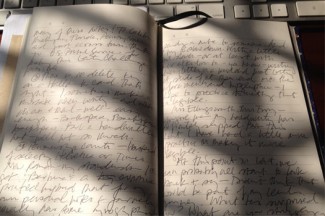 I think my Lenten practice is from a bygone era — maybe a lot of Lenten practices feel that way in today’s contemporary society. I’ve gone back to what feels like the age of quill pens and ink. So strange and different from keyboards and screens. I’ve been affirmed in my efforts by the overwhelming positive response from people receiving my handwritten notes, the readers of this blog about my handwritten notes (thank you!), and an article in The New York Times.
I think my Lenten practice is from a bygone era — maybe a lot of Lenten practices feel that way in today’s contemporary society. I’ve gone back to what feels like the age of quill pens and ink. So strange and different from keyboards and screens. I’ve been affirmed in my efforts by the overwhelming positive response from people receiving my handwritten notes, the readers of this blog about my handwritten notes (thank you!), and an article in The New York Times.
Over the years, I’ve received plenty of note cards and stationery as gifts. I have many beautiful journals from friends who know I like to write and actually write on paper. I have a really nice pen from Muir Woods in California. (Thanks Chris!) And most people who know me and work with me know I write on everything. Post-its. Legal pads. Day planners and calendars. Giant white boards. Scraps of paper. The margins of magazines. The back of a receipt. Etc.
This affection for handwriting — “handwritten anything” as the title says — for being connected to pen and paper — is something I’ve really been able to enjoy and prioritize during Lent. And that feels really good. It makes me think about how I’m going to continue this practice after Lent. I’m hoping it becomes easier to make the move to send a card or note. Do I really need to send so-and-so a card? Really? Yes. Yes I do. And I will really enjoy it.
I hope that upon Lenten reflection or “spiritual examination” you too will be able to find deeper meaning in your Lenten practice. That’s the important thing — not to struggle with days you’ve missed prayer or volunteering if that was your “Lenten thing.” Or (specifically for Catholics) the moment when you were chowing down on a roast beef sandwich and remembered that it was … uh … Friday! (Ooops!) No — the deeper meaning you muster or connect with in your Lenten practice is the thing to take with you after the days in the desert. You don’t necessarily want to forget your struggles — they can teach you something, too — but the story doesn’t end there. I don’t think when Jesus left the desert after being tempted he would stop telling the story when he got to the moment he considered caving. No — he went on and recalled the moments when he stayed close to God and found refuge from the devil, those are the important parts of the Lenten journey.
P.S. — A special thank you to Busted Halo reader/commenter Kat Graham for the “handwritten anything” mention in her comment on my first post. It was the inspiration for this one!